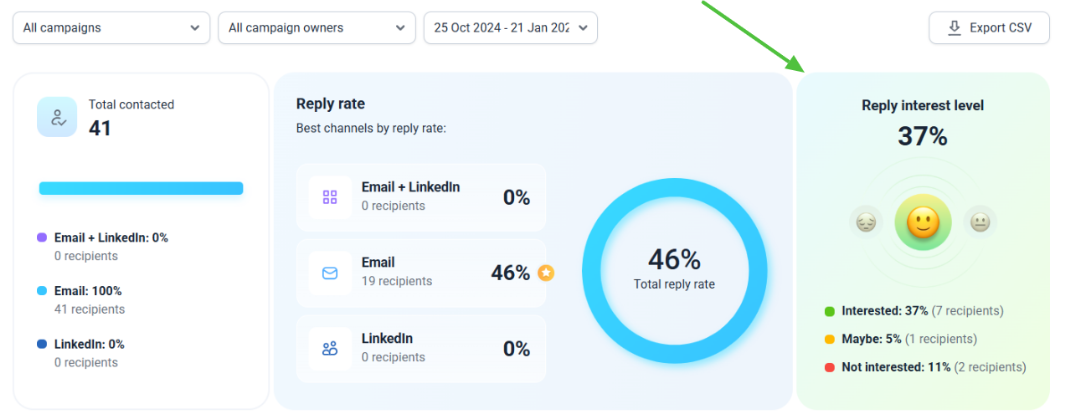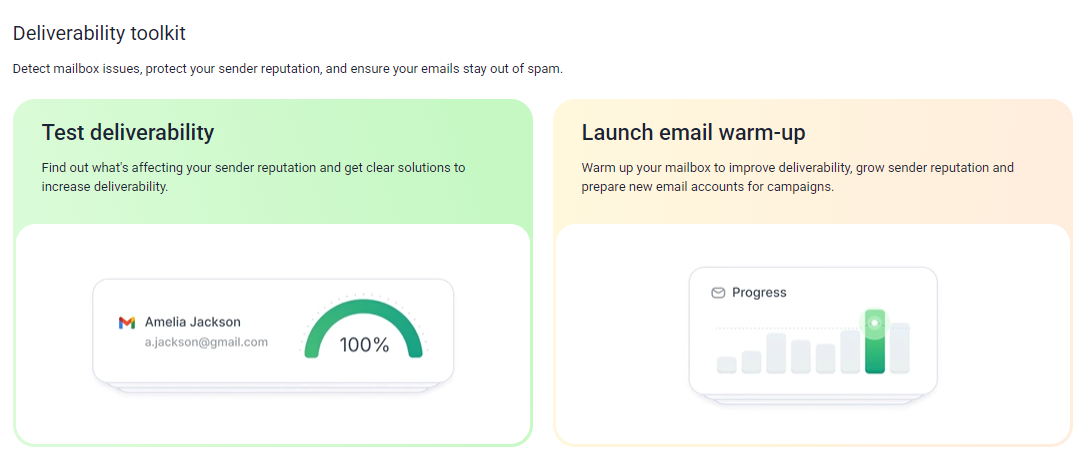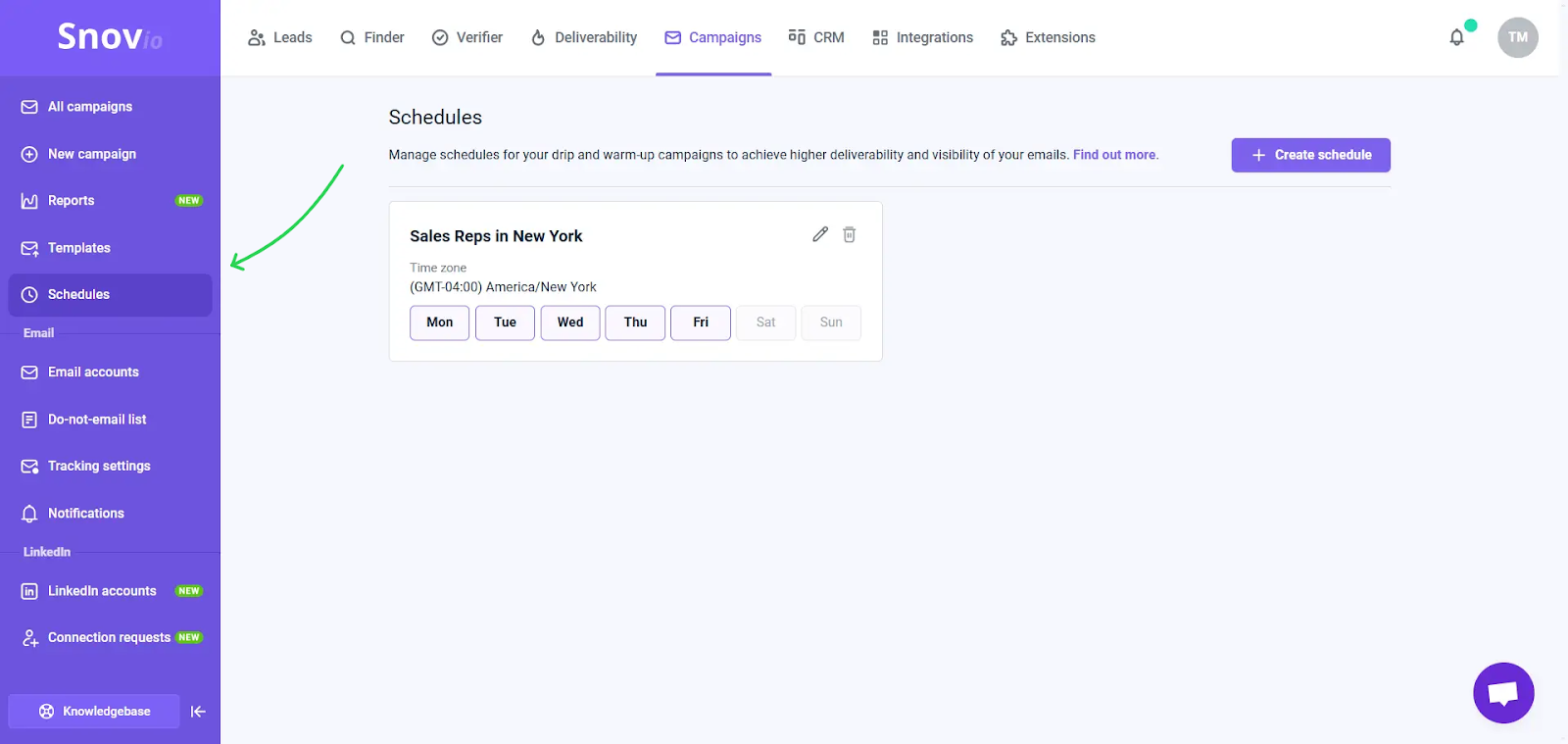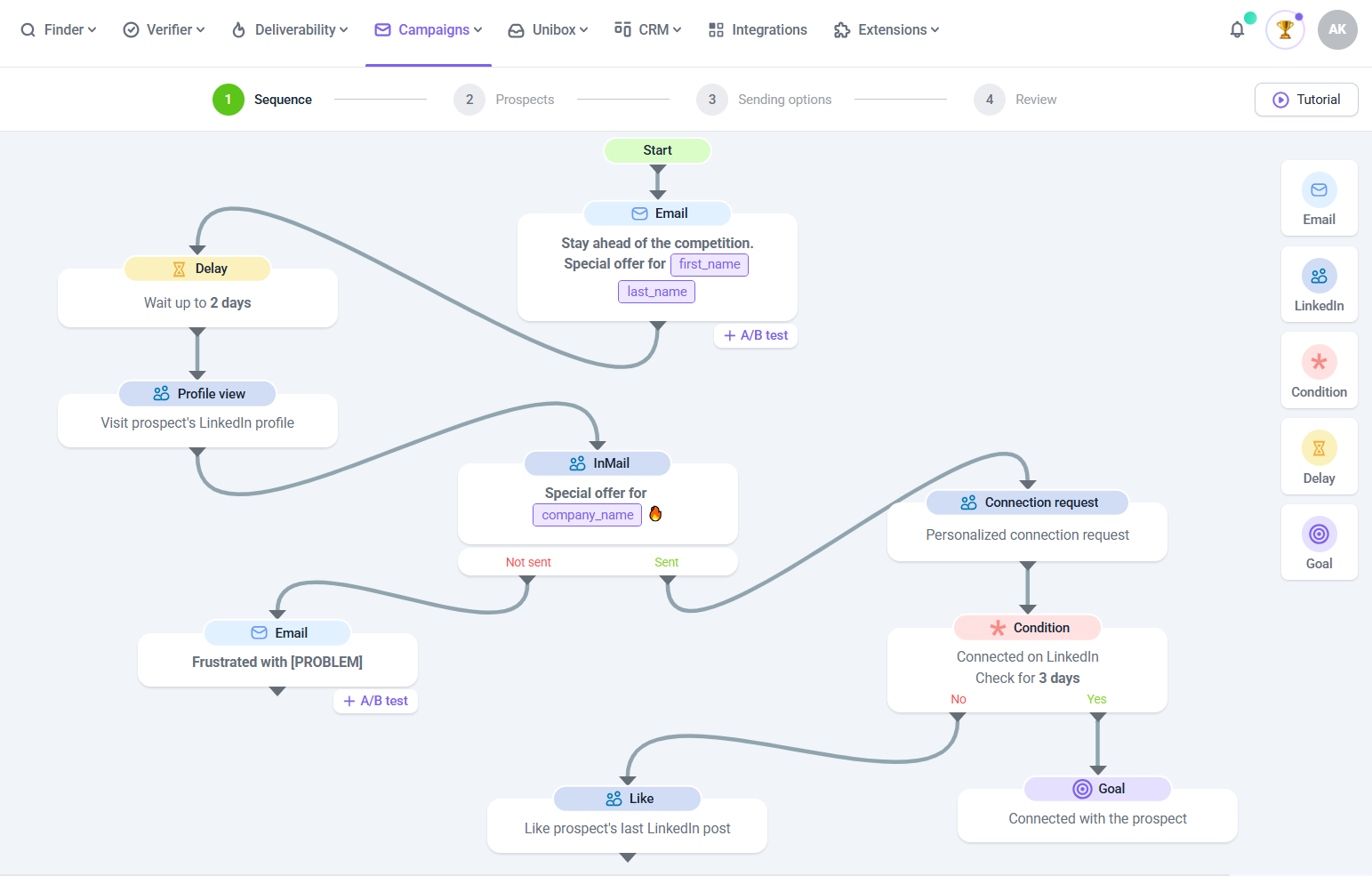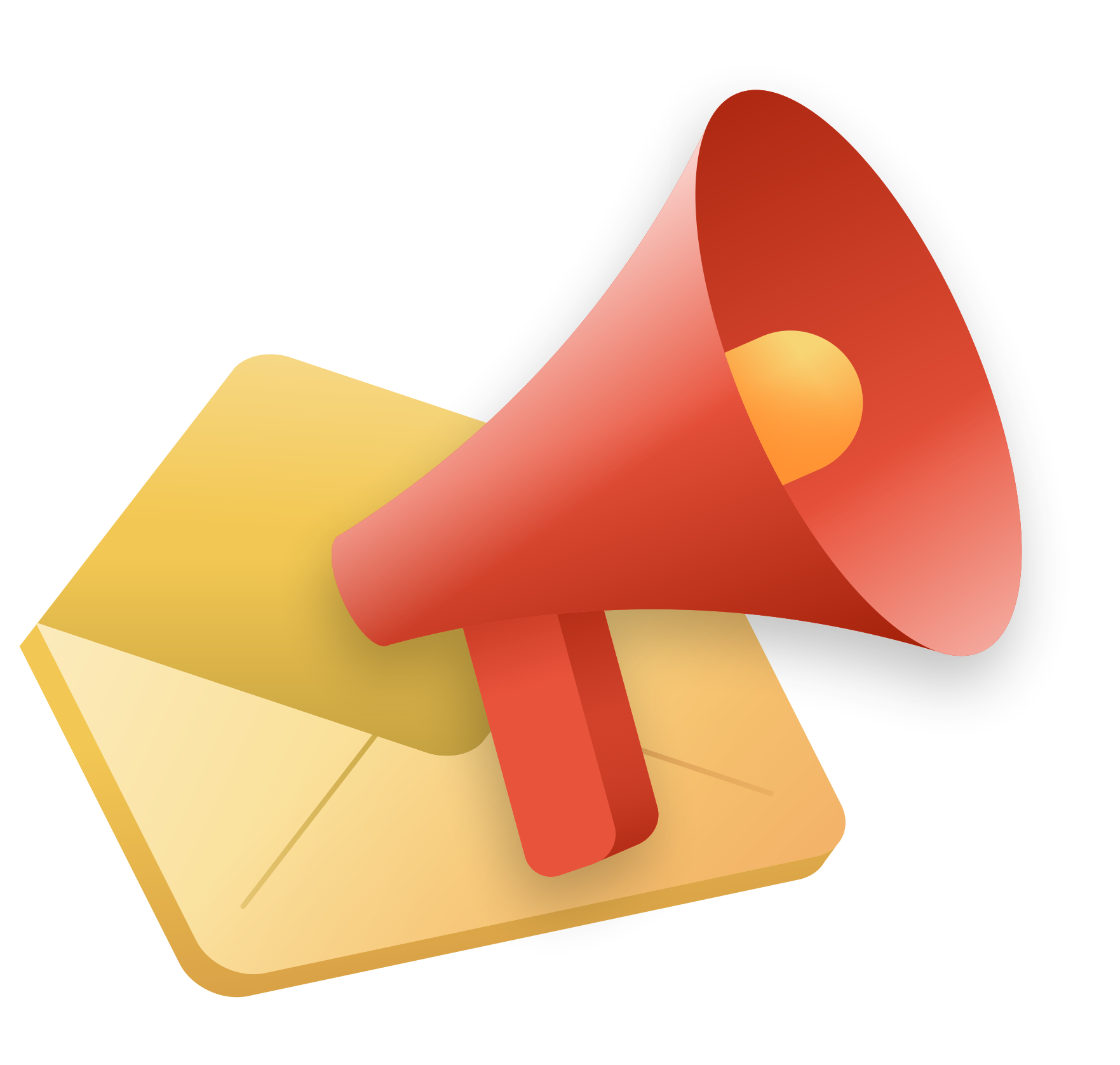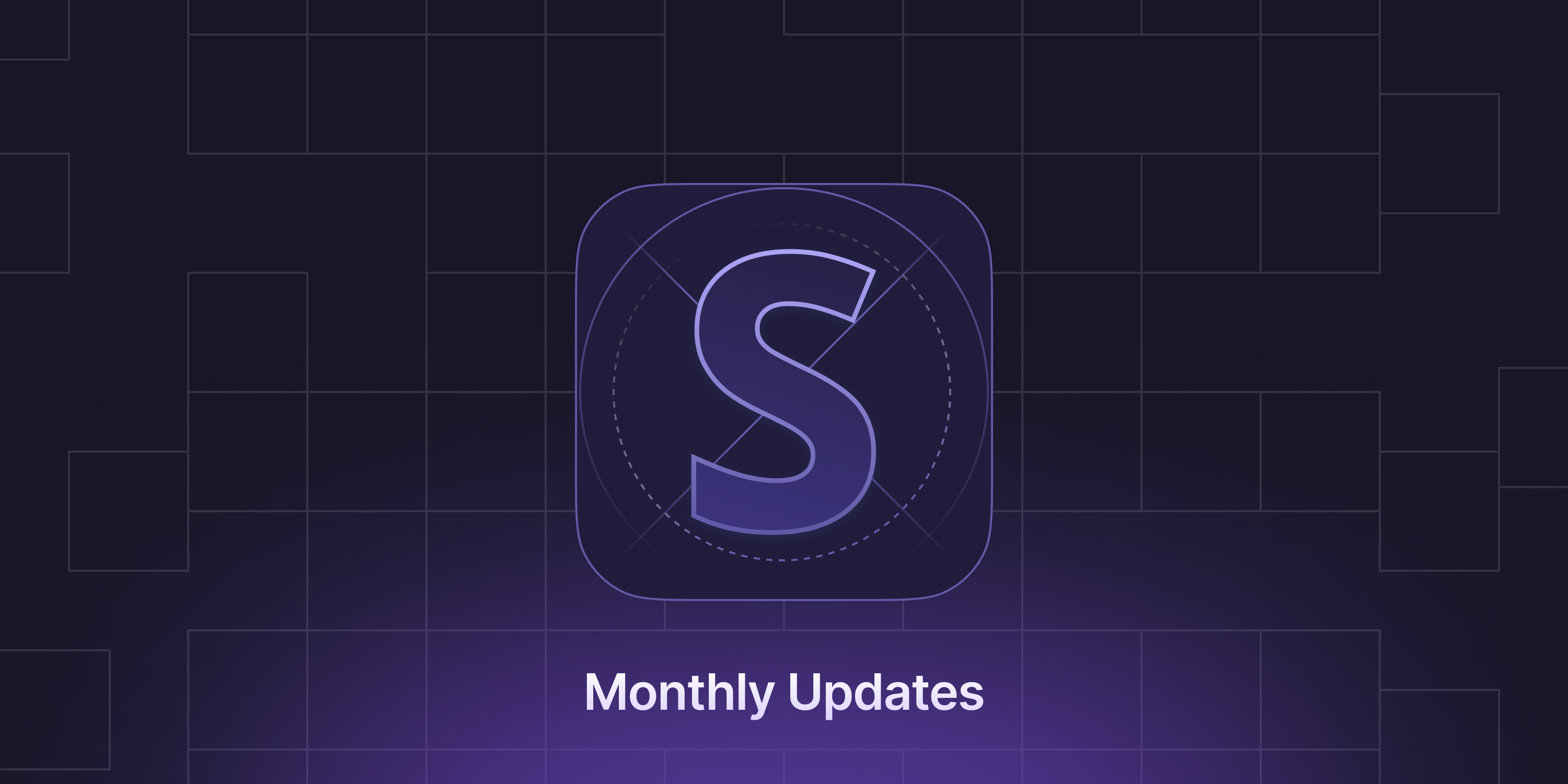TL;DR:
Here are the highlights selected by our editor:
- The average cold email open rate in 2026 is 27.7%.
- Wednesday 7-11 a.m. is the best time for getting replies.
- A 2-email sequence with one follow-up generates most responses (6.9%).
- For more replies, send ½ paragraph-long cold emails, fewer than 100 characters without attachments.
- To boost metrics, focus on deliverability, utilize hyper-personalization techniques, and segment your list effectively. Schedule sequences based on your audience’s timing preferences and test your campaigns regularly.
Support your metric optimization with powerful outreach solutions like Snov.io’s cold outreach automation.
Cold emails remain one of the most cost-effective strategies for generating leads and driving sales. Especially when done smartly. But how do you know if your approach is right? Are your metrics actually good, or could they be better?
In this guide, we’ll break down the latest cold email statistics for 2026, so you can compare your performance with existing benchmarks. Learn the average response rate for cold emails, what open rate is good for your industry, and other stats to measure your success and grow faster.
What you’ll learn:
General cold email statistics
Let’s look at the state of cold email in 2026:
- In B2B, about 61% of decision-makers prefer email as the primary channel for outreach.
- 37% of decision-makers receive more than 10 emails per week.
- However, 20% claim none of them are relevant.
- 73% of decision-makers claim personalization matters for cold outreach.
As for B2C, you’ll hardly find true stats. Most statistics refer to newsletters, marketing drip, and other permission-based campaigns rather than the cold outreach itself.
This issue lies within strict compliance boundaries. Sending cold emails to individual consumers is heavily restricted by laws like CAN-SPAM and GDPR. That’s why most B2C campaigns are targeted at people who’ve already opted in.
Anyway, some findings can be found. According to the Emailtooltester report:
- 38% of surveyed consumers prefer companies to contact them by email.
- On average, people receive 15 cold emails per week.
- 51.4% of them come from companies in the health and beauty industry.
- 44.7% of the surveyed consumers consider messages to be trustworthy, while 36.2% of respondents don’t trust them at all.
Cold email open rate statistics in 2026
The open rate is the first sign of how your campaigns perform. This metric shows whether your message reaches the right people and sparks their interest. Looking into the relevant cold email stats may provide valuable insights on how to improve your subject lines, sender reputation, and overall targeting strategy.
Average cold email open rate (B2B vs B2C)
The latest B2B cold outreach stats reveal:
- The average cold email open rate for B2B across all industries is 27.7%.
Due to better personalization and sender authorization practices, this metric has increased over the last years. In 2019, for instance, the average open rate for cold emails was only 16.6%.
- The average cold email open rate among C-level executives is 28.1%.
- For non-C-level executives, this rate is 27.3%.
For B2C, according to Emailtotester’s report:
- 51.4% of them come from companies in the health and beauty industry.
- 44.7% of the surveyed consumers consider messages to be trustworthy, while 36.2% of respondents don’t trust them at all.
|
💡 Expert tip Based on our analysis of over 44 million emails sent through our platform between February and March 2025, we found that turning off open tracking more than doubled reply rates—2.36% compared to just 1.08%. We recommend tracking other metrics, such as links or meetings booked via Calendly, to ensure your campaigns perform best. |
What is a good open rate for cold emails?
According to Belkin’s recent report
- In general, a good open rate for cold emails in 2026 is considered to be above 45%.
- Businesses operating in the software industry have the highest open rates – 47.1%.
- The lowest average open rates are shown by companies in the consumer goods (19.3%) and banking (19.7%) industries.
Below are cold email benchmarks for various industries that you can take as a reference point; aim for higher metrics to show strong performance.
| Industry | Open rate* |
|---|---|
| Software | 47.1% |
| Education | 40.4% |
| Marketing & advertising | 35.7% |
| E-learning & edtech | 34.8% |
| IT security | 33.3% |
| Real estate | 32.6% |
| Construction | 32% |
| Leisure, travel & tourism | 31.6% |
| Hospitality | 29.3% |
| Legal service | 27.3% |
| Telecoms | 27.2% |
| IT services & IT consulting | 26.2% |
| IT services & IT consulting | 26.2% |
| E-commerce | 25.9% |
| Healthcare | 25.5% |
| Tobacco, cannabis & CBD | 25.4% |
| Transportation & logistics | 25.2% |
| Accounting | 23.8% |
| Financial services | 22.8% |
| Insurance | 22% |
*Based on Belkin’s 2024 study
Cold email subject line statistics
Subject lines directly influence whether your email will be opened or not. Here is what numbers tell us about their impact on open rates:
- According to Zippia’s research, approximately 64% of people make a decision to open an email based on a subject line, while 33% of recipients will do it if the subject line is catchy.
- Zerobounce provides a bit higher percentage: 43% of people will engage with a message that has an attention-grabbing subject line.
- Interestingly, based on Mailchimp’s study, subject lines that include both recipients’ first and last names influence open rate most positively (33%).
- Using just last names in subject lines brings a 17% open rate.
- Using only first names in subject lines generates only a 9% open rate.
- According to a study conducted by Yesware, subject lines that include numbers generate 45% higher open rates.
- Subject lines framed as questions may bring you a 10% higher open rate.
We can clearly see that questions spark more interest in recipients.

What about salutations in subject lines?
- Generic greetings, such as “Hello” or “Friend”, used in subject lines can lower open rates to 9%.
- As is stated in Belkin’s report, subject lines that are three, seven, or eight words long show the highest open rates (33%).
- Surprisingly, subject lines in uppercase have the highest open rates of 35%, while subject lines in Sentence case show an open rate of 24%.
🤔 How to find out which subject lines work best in YOUR campaigns?
Identify the most effective subject lines with the Snov.io A/B testing feature. You can include up to 15 variations to each step of your campaigns, so don’t limit yourself.
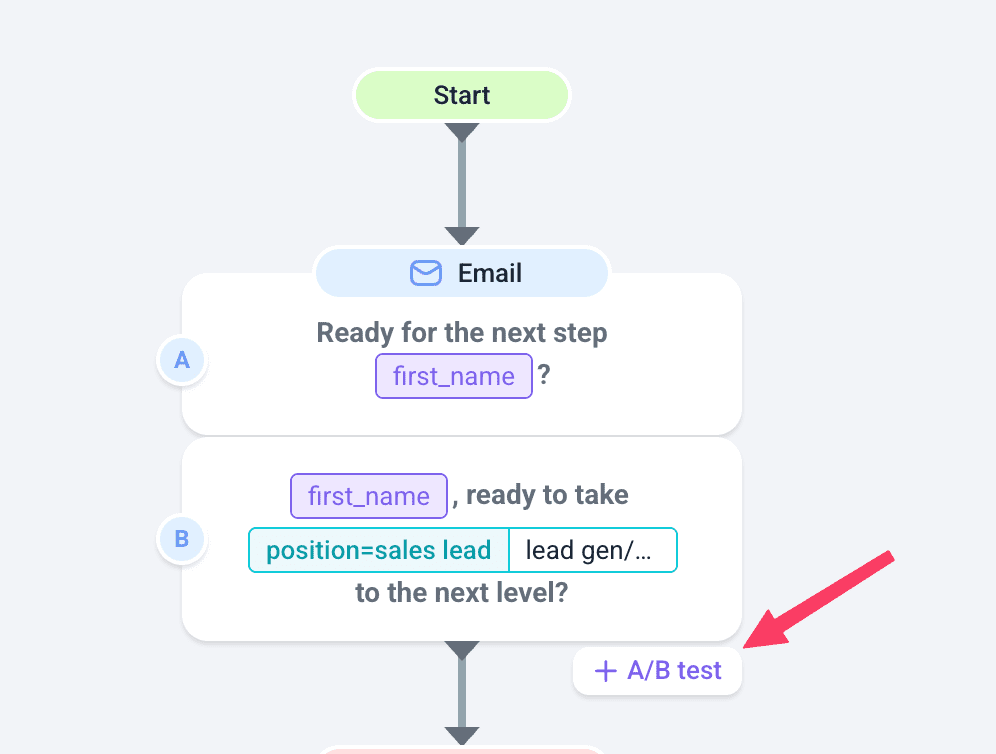
Experiment with subject line length, style, case, CTA, wording, or any other idea you have to see what drives opens in your niche.
Cold email response rate statistics in 2026
The response rate indicates whether your recipient is interested in the content of your message. But what is a good reply rate for cold email? Let’s review relevant emailing statistics and industry benchmarks to figure it out.
The average reply rate for cold email
The average email response rate is lower than the open rate. According to Belkin’s report:
- The average response rate for cold emails is 5.1%.
- The average cold email response rate for C-level professionals is 4.2%, while for non-C-level executives, it is 5.6%.
- Emails to HR specialists show the highest reply rate of 8.5%.
- Sequences sent to fewer than 100 recipients drive the highest reply rate, up to 5.5%.
But what response rate truly counts as “high”?
What is a good response rate for cold email in 2026?
Considering cold email benchmarks mentioned above:
- A truly good cold email reply rate in 2026 is 10%.
- Legal services companies have the highest response rate across industries, up to 10%.
- Businesses operating in the software sector show the lowest response rates (less than 1%).
But keep in mind that this is a general score, not tied to any specific industry. B2B cold email response rates depend on the niche and the target recipients. So don’t be discouraged if your results are slightly lower. Take benchmarks for various industries as a reference point and aim for higher open rates:
| Industry | Reply rate* |
|---|---|
| Legal services | 10% |
| E-learning & edtech | 7.9% |
| Chemicals | 7.4% |
| Hospitality | 6.9% |
| Transportation & logistics | 6.8% |
| Banking | 6.6% |
| Food & beverage | 6.4% |
| IT security | 6.3% |
| Management consulting | 6% |
| Real estate | 5.8% |
| Insurance | 5.5% |
| Accounting | 5.5% |
| Telecoms | 5.2% |
| Healthcare | 4.9% |
| E-commerce | 4.8% |
| Financial services | 4.8% |
| Marketing & advertising | 4.4% |
| IT services & IT consulting | 3.7% |
| Biotechnology | 3.6% |
| Software | 0.5% |
However, if you’re seeing a response rate lower than 5%, it may be a sign that your campaign needs optimization.
|
💡 Expert tip When it comes to cold outreach and sales, response rate is often considered a key metric for measuring engagement. But what matters most is the quality of these responses. You can track it with Snov.io’s Sentiment analysis. This feature uses AI to analyze all replies and determine your recipients’ level of interest. Thus, you can identify prospects with the highest potential and focus your efforts on them rather than on less promising leads. |
Now, let’s move on to the conversion rate.
Cold email conversion rate statistics in 2026
The ultimate sales goal isn’t high reply rates — it’s conversions. And not every reply is equal to a conversion. So, first, let’s define what can be considered a conversion in cold outreach, and then dive into key emailing statistics.
What is a conversion in cold emailing (reply, meeting booked, etc.)?
Typically, a conversion means that your recipient took a desired action. This can be a booked meeting, a positive reply (or any reply at all), a purchase, signing up for a trial, and so on.
Average cold email conversion rate
According to recent Focus Digital research:
- The average conversion rate for cold emails is 0.2153%.
- This conversion rate means that one deal is secured for every 464 emails sent.
- Personalization can improve this metric by 10%.
Again, to find your optima, refer to the average cold email conversion rate benchmarks, which differ from industry to industry:
| Industry | Conversion rate* | Emails needed to close the deal |
|---|---|---|
| SaaS (Software as a Service) | 0.0308% | 3249 |
| IT Services | 0.0417% | 2398 |
| Cybersecurity | 0.0525% | 1905 |
| Cloud Computing | 0.0634% | 1578 |
| Consulting Services | 0.0742% | 1347 |
| Marketing and Advertising | 0.0851% | 1176 |
| Financial Services | 0.0960% | 1042 |
| Legal Services | 0.1068% | 937 |
| Human Resources and Recruiting | 0.1177% | 850 |
| Machinery and Equipment | 0.1286% | 778 |
| Electronics | 0.1394% | 718 |
| Automotive | 0.1502% | 667 |
*Based on a 2024 study by Focus Digital
Cold email timing, length, frequency, and delivery insights
Your cold outreach success largely depends on what you send, when you send it, and how often you reach out. Let’s dive into helpful insights and cold outreach statistics on email length, scheduling, and quantity.
Best days/times to send emails in 2026
Based on Beklins’ study:
- July boasts the highest response rate among all months (6.3%), while December shows the worst results (4.67%).
- Cold email open rates are the highest on Tuesday (28.2%) and Wednesday (27.5%).
- People are most likely to respond between 7:00 and 11:00 a.m.
- Wednesday sees the highest cold email response rate at 5.8%.
- The worst days regarding response rates are Mondays and Fridays, at 5.1% each.
Time of day also matters, as evident here:

- According to Emailtotester’s report, for B2C campaigns, the optimal sending time is between 5 a.m. and 8 a.m. on Monday, with an average response rate of 2.3%.
🤔 Stats are not enough?
Get a complete guide to cold emailing in just five minutes here:
Average email deliverability rate and unsubscribe rate
According to cold email statistics, provided by QuickMail:
- The average unsubscribe rate is 2.17%.
- The average bounce rate is 7.5%.
- A good deliverability rate for cold outreach is anything above 95%.
How many cold emails do you need to get a reply or a client?
There is no universal rule for each campaign, industry, or business type. However, the best option is to send no more than 2-3 follow-ups to not overwhelm your prospect.
Here is what the follow-up stats say:
- Cold email response rates can increase by nearly 49% after one follow-up.
- Two follow-ups can bring 3.2% more responses.
- Three follow-up drops responses by 30%.
- More so, sending the fourth follow-up may result in a 1.6% spam rate and 2% unsubscribe rate. This may be detrimental to your sender reputation, so don’t exceed three follow-ups per sequence.
- Belkin’s study revealed that a 2-email sequence with one follow-up shows the highest response rate at 6.9%.
- The best time to follow up is 3 days after sending your initial message.
How long should cold emails be?
Let’s take a look at what cold email stats say:
- According to Belkin’s study, emails with fewer than 100 characters show the highest response rate, reaching up to 5.4%.
- Messages that don’t contain any attachments or graphic materials have almost 2x higher reply rate.
- However, visual materials may slightly increase your click-through rate (CTR) from 0.51% to 0.84%.
- Emails between 100 and 200 characters show the lowest bounce rate, at just 1.9%.
- 1-2 paragraphs work best, showing a response rate of 3.8%.
- Messages with shorter sentences (fewer than 10 words) receive the highest response rates.

8 Cold Email Templates And Strategies For Lead Generation
December 23 2025
How to improve your cold email metrics: tips and tools from Snov.io
Now that you know cold email statistics and key benchmarks, let’s explore how to improve your results. Here are practical tips to optimize your campaigns:
Improve deliverability
How can prospects reply if your campaigns never reach their inboxes? Focusing on inbox placement should be step number one. Before starting cold outreach, set up proper authentication (SPF, DKIM, DMARC) and utilize warm-up tools to establish a strong sender reputation.
Looking for an advanced yet user-friendly solution to improve inbox placement? With Snov.io Email Warm-up, you can find a ready-to-use warm-up strategy that fits your specific goals. Whether you’re preparing a new domain for cold campaigns or want to fix your domain reputation, you’ll be able to grow deliverability automatically, sparing hours of your precious time.
Aim for hyper-personalization
Therefore, to make your cold outreach more impactful, go beyond using first names. Reference a prospect’s company, role, or recent activity. You can also mention shared connections to build instant relevance and trust.
With Snov.io’s Cold Email tool, for example, you can personalize your bulk messaging on autopilot. Its advanced Dynamic content variables will help personalize each message in your sequence on the go, so it feels relevant and warm.
Meanwhile, with Snov.io’s Personalized AI Email Builder, you can create targeted messages based on your ICP and unique selling points.
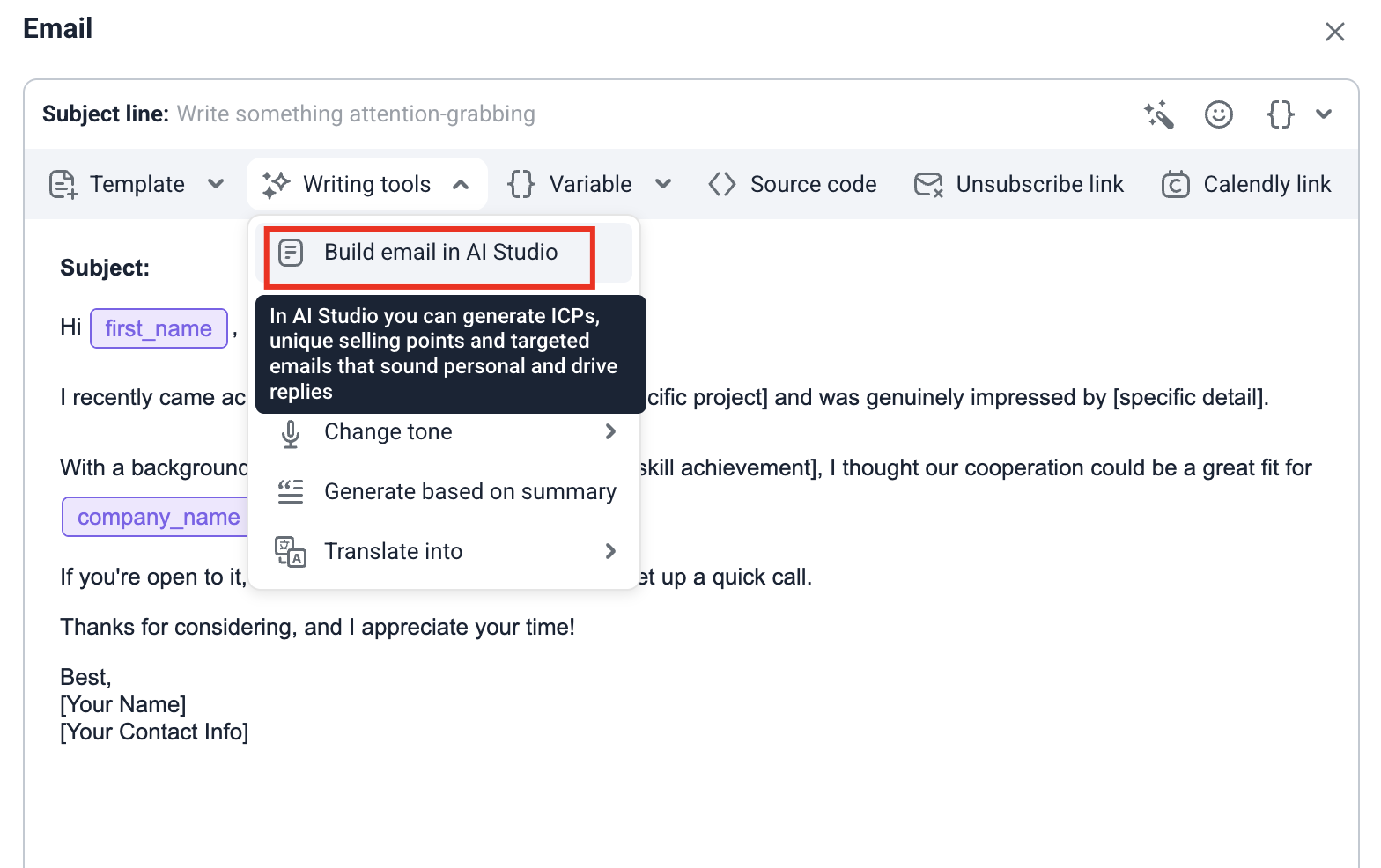
No matter how many prospects are on your list, Snov.io’s AI-powered features will make each email feel personal and relevant to your prospects.
Segment your lead list
How do you ensure your outreach is relevant to all your leads? Group them by shared characteristics and tailor your messaging at scale. By segmenting your leads based on industry, job role, location, or other criteria, you can create emails that resonate with each group. More targeted cold outreach always brings better results.
Optimize your sending schedule
Timing can make or break your open and response rates. Never send campaigns randomly! Instead, learn about your audience to align your schedule accordingly. The cold email statistics provided in this article will also be helpful.
Provide a catchy subject line and a clear CTA
Subject lines open the doors to your outreach, so make them:
- attention-grabbing
- relevant
- clear
Meanwhile, CTA can significantly impact your reply rates. Ensure your recipient understands what you want them to do. Avoid vague phrases like “Let me know what you think.” Instead, consider adding action-oriented call-to-actions, such as “Would you be open to a 15-minute call?” to guide your prospect to the desired action.
Follow up strategically
Don’t give up after the first email. Most replies come after 2-3 follow-ups. Create a compelling follow-up sequence to move your prospect towards a response/action. Don’t repeat yourself in follow-ups – add fresh value to keep your cold campaigns effective.
A/B test to spot what’s working
Experiment with various approaches through A/B testing and analyze your results to identify the most effective options. Try out different subject lines, CTAs, texts, and other elements to see what works best. With valuable insights you gain, you’ll be able to adjust your next campaigns — a key strategy for boosting cold email open rates and other metrics.
The idea is simple: if we don’t keep our strategies fresh, we might miss out on connecting with potential clients. Our recent tweaks have upped our response rates to a steady 3-4%, but who knows how long that’ll last? So, we constantly optimize and test. Personalized content and smart timing are the main ingredients that grab the attention of busy execs.
VP of Sales at Snov.io
Key takeaways
Statistics prove that cold emailing still works in 2026, if done smartly. Use the cold email benchmarks mentioned in this article to measure and adjust your performance based on your industry metrics.
To improve the results, focus on smart segmentation, hyper-personalization, and inbox placement growth practices. Do regular A/B testing to find what works best for your audience.
And whenever you need a sales boost, Snov.io is always at your disposal. Enhance deliverability, automate outreach, and personalize bulk cold emails all under one roof.

